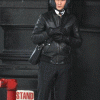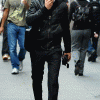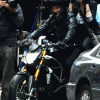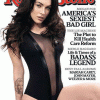New York Magazine christened the summer of 2009, "the Summer of Death." And there can be little argument that it is not a fitting sobriquet. This summer saw the deaths of such celebrities as Walter Cronkite, Ed McMahon, Farrah Fawcett, John Hughes, Edward Kennedy, Patrick Swayze, and yet others. For the whole of the summer it seemed as if the news was little more than an endless stream of obituaries. If nothing else would, it would seem the summer of 2009 would put an end to the old idea that celebrities die in threes. This summer, it seemed as if they died in sixes and even twelves.
That having been said, I think it might not quite be accurate to call 2009 the "Summer of Death." The reason for this is simply that it seems to me that the celebrity deaths did not start with the summer of 2009 or even the spring of 2009. They started with the very beginning of the year. Character actor Pat Hingle died when 2009 was only three days old. Later in January Patrick McGoohan, Ricardo Montalbahn, and Sir John Mortimer (creator of Rumpole of the Bailey) died. As the year progressed, 2009 would see the deaths of James Whitmore, Philip Jose Farmer, Wendy Richard, Paul Harvey, Natasha Richardson, J. G. Ballard, Bea Arthur, David Carradine, and yet others all pass well before summer. It is now autumn and no celebrities have died yet. The way this year has been going, however, it seems likely there will be more celebrity deaths.
Of course the $64,000 question is why there have been so many celebrity deaths this year. I think the primary reason is that many of those who were central to Anglo-American pop culture are simply getting old. Walter Cronkite was 92 years old. Ed McMahon was 86, as was Bea Arthur. Ricardo Montalbahn was 88. Patrick McGoohan was 80. It is a sad fact of life that human beings are not immortal. We are all going to die at some point, and that reality becomes more likely with advancing age.
While many of the celebrities who have died have been old, it does seem as if many of them simply died young. A prime culprit was cancer. It took Farrah Fawcett at the age of 62. It took Patrick Swayze at the age of 57. It took Wendy Richard at the age of 65. Other celebrities died young from other causes. Natasha Richardson was only 45 when she died from a head injury. John Hughes died of a heart attack at the age of 59. Character actor Dale Swann died at the age of 61 from complications from a stroke. There is no rational explanation for the extreme number of relatively young celebrities who have died from many different causes this year. It seems that instead of taking a holiday, Death has decided to work overtime.
We can only hope that in these last few months of 2009 fewer celebrities die. As it is there was a time when it seemed as if a day could not go by, let alone a week, with the news of some celebrity's death. I rather suspect that more celebrities have died in 2009 than some two years combined. In the end, it seems as if the most fitting toast this coming New Year's Eve might be, "To absent friends."
Wednesday, 30 September 2009
Monday, 28 September 2009
Actor Robert Ginty Passes On
Robert Ginty, an actor who was a regular on both Baa Baa Black Sheep and The Paper Chase, passed on September 20 at the age of 60. The cause was cancer.
Robert Ginty was born in Brooklyn on November 14, 1948. He attended both Yale and the City College of New York. He studied acting at the Neighbourhood Playhouse in New York City. Interested in music from an early age, he eventually became a rock drummer. He even played with such legends as Jimi Hendrix and Janis Joplin. After his band appeared in a movie, Ginty was encouraged to go into acting.
Robert Ginty appeared in regional theatre early in his career. In 1972 he was the understudy on the Broadway plays The Great God Brown and Don Juan. He worked for a time as the assistant to Broadway producer Harold Prince. In the early Seventies he moved to Los Angeles. There he made his first appearances on television in episodes of Nakia and The Rockford Files in 1974. Ginty guest starred on the shows Police Woman, Joe Forrester, and Jigsaw John. He also appeared in the films Two Minute Warning and Bound for Glory. It was in 1976 that he became one of the original, regular characters on Baa Baa Black Sheep. He played Lt. T. J. Wiley on the show for nearly the entirety of its run. It was in 1978 that he became a regular on the television series The Paper Chase, on which he played Thomas Craig Anderson.
It was in 1980 that Robert Ginty played the lead in the film The Exterminator. A low budget film of the Death Wish genre, The Exterminator performed very well at the box office. Ginty appeared in similar, low budget action films, such as Scarab, Programmed to Kill, Three Kinds of Heat, and Code Name Vengeance, and The Bounty Hunter. He also appeared in the low budget sci-fi film Warrior of the Lost World and the horror movies The Alchemist and Maniac Killer. Ginty continued to appear in TV shows, including Simon and Simon and Knight Rider. He was a regular on the show Hawaiian Heat in 1983 and appeared for a story arc on Falcon Crest. In the Nineties Ginty appeared in the movies Madhouse, Harley Davidson and the Marlboro Man, Lady Dragon, and The Prophet Game. He appeared on the shows Murder She Wrote and In the Heat of the Night.
Ginty also directed movies and television shows. He directed the low budget action films The Bounty Hunter and Vietnam, Texas. He also directed episodes of the shows Dream On, China Beach, Evening Shade, Xena Warrior Princess, Lois & Clark: The New Adventures of Superman, Charmed, and Tracker.
Robert Ginty was born in Brooklyn on November 14, 1948. He attended both Yale and the City College of New York. He studied acting at the Neighbourhood Playhouse in New York City. Interested in music from an early age, he eventually became a rock drummer. He even played with such legends as Jimi Hendrix and Janis Joplin. After his band appeared in a movie, Ginty was encouraged to go into acting.
Robert Ginty appeared in regional theatre early in his career. In 1972 he was the understudy on the Broadway plays The Great God Brown and Don Juan. He worked for a time as the assistant to Broadway producer Harold Prince. In the early Seventies he moved to Los Angeles. There he made his first appearances on television in episodes of Nakia and The Rockford Files in 1974. Ginty guest starred on the shows Police Woman, Joe Forrester, and Jigsaw John. He also appeared in the films Two Minute Warning and Bound for Glory. It was in 1976 that he became one of the original, regular characters on Baa Baa Black Sheep. He played Lt. T. J. Wiley on the show for nearly the entirety of its run. It was in 1978 that he became a regular on the television series The Paper Chase, on which he played Thomas Craig Anderson.
It was in 1980 that Robert Ginty played the lead in the film The Exterminator. A low budget film of the Death Wish genre, The Exterminator performed very well at the box office. Ginty appeared in similar, low budget action films, such as Scarab, Programmed to Kill, Three Kinds of Heat, and Code Name Vengeance, and The Bounty Hunter. He also appeared in the low budget sci-fi film Warrior of the Lost World and the horror movies The Alchemist and Maniac Killer. Ginty continued to appear in TV shows, including Simon and Simon and Knight Rider. He was a regular on the show Hawaiian Heat in 1983 and appeared for a story arc on Falcon Crest. In the Nineties Ginty appeared in the movies Madhouse, Harley Davidson and the Marlboro Man, Lady Dragon, and The Prophet Game. He appeared on the shows Murder She Wrote and In the Heat of the Night.
Ginty also directed movies and television shows. He directed the low budget action films The Bounty Hunter and Vietnam, Texas. He also directed episodes of the shows Dream On, China Beach, Evening Shade, Xena Warrior Princess, Lois & Clark: The New Adventures of Superman, Charmed, and Tracker.
Sunday, 27 September 2009
Cowboy Actor John Hart and Writer Norman Katkov Pass On
John Hart
 John Hart, the actor best known for taking over the role of The Lone Ranger from Clayton Moore for a short time, passed on September 20 at the age of 91. He also played Jack Armstrong in the serial Jack Armstrong All-American Boy and Hawkeye in the Fifties TV series Hawkeye and the Last of the Mohicans.
John Hart, the actor best known for taking over the role of The Lone Ranger from Clayton Moore for a short time, passed on September 20 at the age of 91. He also played Jack Armstrong in the serial Jack Armstrong All-American Boy and Hawkeye in the Fifties TV series Hawkeye and the Last of the Mohicans.John Hart was born December 13, 1917 in Los Angeles, California, but grew up in San Marino, California. His mother was a drama critic for The Pasadena Star-News. As a young man he worked as a cowboy in the summers.
Before appearing in films, John Hart acted in a number of productions at the Pasadena Playhouse. He made his film debut in an uncredited role as a sailor in Daughter of Shanghai in 1937. After appearing in an uncredited part in The Buccaneer in 1938, Hart was signed to Paramount. Even so, most of Hart's roles prior to World War II tended to be small and often uncredited. He appeared in such films as King of Alcatraz, Million Dollar Legs, and North West Mounted Police. His acting career was interrupted by World War II. He was drafted into the United States Army in 1941. He would not return to acting until 1947.
John Hart's first role after the war was as Big Jim in the musical Vacation Days. He played Jack Armstrong in the Columbia serial Jack Armstrong All-American Boy that same year. John Hart would find steady employment in both serials and Westerns. He appeared as Dent in the serial Brick Bradford, as a henchman in the serial The Adventures of Batman and Robin, and a henchman in Atom Man vs. Superman. He appeared in such B Westerns as Cowboy and the Prizefighter, Colorado Ambush, Stagecoach Driver, Warpath, and Texas City. He also appeared in such varied films as Pirates of the High Seas, Aladdin and His Lamp, and Thief of Damascus.
John Hart would eventually move into television. He guest starred on The Lone Ranger in 1950, two years before he would play the Masked Man himself. He also appeared on Sky King and Gangbusters. It was in 1952 that he would replace Clayton Moore, who had asked for a pay raise, as The Lone Ranger. The show's producers had reasoned that it was the character, not the actor, who drew viewers to the show. The producers would be proven wrong, however, as the public never quite warmed to Hart as The Lone Ranger. By 1954 Clayton Moore was back in the part.
John Hart would go onto appear in the serial The Adventures of Captain Africa in 1955, and make guest appearances on Tales of the Texas Rangers, Sergeant Preston of the Yukon, and Highway Patrol. In 1957 he played the role in the syndicated series Hawkeye and the Last of the Mohicans. From the Fifties into the Eighties, John Hart would regularly appear in television shows and in movies. During the 1961-1962 season he was a regular on the television Western Rawhide. He guest starred on such shows as The Jack Benny Programme, Ben Casey, The Lieutenant, The Addams Family, Perry Mason, Barbary Coast, and Happy Days, In the 1980-1981 season he was a semi-regular on Dallas. John Hart appeared in movies such as The Shaggy Dog, Marnie, Viva Las Vegas, The Phynx (as The Lone Ranger), and Blackenstein.
John Hart is best known as the other actor besides Clayton Moore to play The Lone Ranger in the Fifties TV series. That having been said, he deserves to be remembered for more. In fact, John Hart did particularly well in heroic roles. If he mostly played in Westerns and action movies it was with good reason. Not only did he look the part , but he was capable of acting convincingly in such parts as well. There can be no doubt that the fact that he had actually worked as a cowboy. Although the role was undoubtedly Clayton Moore's, Hart made a good Lone Ranger and did well in similar roles as well.
Before appearing in films, John Hart acted in a number of productions at the Pasadena Playhouse. He made his film debut in an uncredited role as a sailor in Daughter of Shanghai in 1937. After appearing in an uncredited part in The Buccaneer in 1938, Hart was signed to Paramount. Even so, most of Hart's roles prior to World War II tended to be small and often uncredited. He appeared in such films as King of Alcatraz, Million Dollar Legs, and North West Mounted Police. His acting career was interrupted by World War II. He was drafted into the United States Army in 1941. He would not return to acting until 1947.
John Hart's first role after the war was as Big Jim in the musical Vacation Days. He played Jack Armstrong in the Columbia serial Jack Armstrong All-American Boy that same year. John Hart would find steady employment in both serials and Westerns. He appeared as Dent in the serial Brick Bradford, as a henchman in the serial The Adventures of Batman and Robin, and a henchman in Atom Man vs. Superman. He appeared in such B Westerns as Cowboy and the Prizefighter, Colorado Ambush, Stagecoach Driver, Warpath, and Texas City. He also appeared in such varied films as Pirates of the High Seas, Aladdin and His Lamp, and Thief of Damascus.
John Hart would eventually move into television. He guest starred on The Lone Ranger in 1950, two years before he would play the Masked Man himself. He also appeared on Sky King and Gangbusters. It was in 1952 that he would replace Clayton Moore, who had asked for a pay raise, as The Lone Ranger. The show's producers had reasoned that it was the character, not the actor, who drew viewers to the show. The producers would be proven wrong, however, as the public never quite warmed to Hart as The Lone Ranger. By 1954 Clayton Moore was back in the part.
John Hart would go onto appear in the serial The Adventures of Captain Africa in 1955, and make guest appearances on Tales of the Texas Rangers, Sergeant Preston of the Yukon, and Highway Patrol. In 1957 he played the role in the syndicated series Hawkeye and the Last of the Mohicans. From the Fifties into the Eighties, John Hart would regularly appear in television shows and in movies. During the 1961-1962 season he was a regular on the television Western Rawhide. He guest starred on such shows as The Jack Benny Programme, Ben Casey, The Lieutenant, The Addams Family, Perry Mason, Barbary Coast, and Happy Days, In the 1980-1981 season he was a semi-regular on Dallas. John Hart appeared in movies such as The Shaggy Dog, Marnie, Viva Las Vegas, The Phynx (as The Lone Ranger), and Blackenstein.
John Hart is best known as the other actor besides Clayton Moore to play The Lone Ranger in the Fifties TV series. That having been said, he deserves to be remembered for more. In fact, John Hart did particularly well in heroic roles. If he mostly played in Westerns and action movies it was with good reason. Not only did he look the part , but he was capable of acting convincingly in such parts as well. There can be no doubt that the fact that he had actually worked as a cowboy. Although the role was undoubtedly Clayton Moore's, Hart made a good Lone Ranger and did well in similar roles as well.
Norman Katkov
Writer of screen and television Norman Katkov died on September 13 at the age of 91.
Norman Katkov was born in the Ukraine on July 26, 1918. He was still a child when his family moved to the United States, settling in St. Paul, Minnesota. He graduated from the University of Minnesota in 1940 with a degree in journalism. Afterwards he worked as a police reporter for The St. Paul Pioneer Press. During World War II he served in the United States Army. Following the war he worked for The New York World Telegram. It was also after the war that he started writing short stories for such magazines as Colliers and The Saturday Evening Post.
His first writing for the big screen was uncredited work on the film noir Macao in 1952. His first work on television would be a 1956 episode of General Electric Theatre. Over the next few years he wrote episodes for such shows as Kraft Television Theatre, Studio One, and Steve Canyon. He wrote the screenplay for the Doris Day sex comedy It Happened to Jane.
It was in 1960 that he became one of the regular writers on Wanted Dead or Alive, the Western starring Steve McQueen. He also wrote episodes of Outlaws, Cain's Hundred, 87th Precinct, Dr. Kildare, and The Untouchables. In 1962 he started to write regularly for Ben Casey. He would be nominated for the 1963 Emmy for Outstanding Writing Achievement in Drama for the episode "A Cardinal Act of Mercy" for the show. After Ben Casey ended, Norman Katkov would write for such shows as The Wild Wild West, The Loner, The Virginian, Bonanza, Mannix, Ironside, Dan August, Mission: Impossible, and Kung Fu. He was the story editor for the short lived series Banyon. He also wrote the screenplay for Once You Kiss a Stranger.
Norman Katkov also wrote novels, including A Little Sleep, A Little Slumber and Blood and Orchids,
Norman Katkov was one of the better writers to work in television. The teleplays he wrote always featured strong characters and equally strong plots. Indeed, he wrote one of the better episodes of The Wild Wild West, "The Night of the Human Trigger," and two of the best episodes of Kung Fu. He was a writer who approached television with the same eye for quality that he did his novels. Katkov was only nominated for one Emmy, but he should have been nominated for more.
It was in 1960 that he became one of the regular writers on Wanted Dead or Alive, the Western starring Steve McQueen. He also wrote episodes of Outlaws, Cain's Hundred, 87th Precinct, Dr. Kildare, and The Untouchables. In 1962 he started to write regularly for Ben Casey. He would be nominated for the 1963 Emmy for Outstanding Writing Achievement in Drama for the episode "A Cardinal Act of Mercy" for the show. After Ben Casey ended, Norman Katkov would write for such shows as The Wild Wild West, The Loner, The Virginian, Bonanza, Mannix, Ironside, Dan August, Mission: Impossible, and Kung Fu. He was the story editor for the short lived series Banyon. He also wrote the screenplay for Once You Kiss a Stranger.
Norman Katkov also wrote novels, including A Little Sleep, A Little Slumber and Blood and Orchids,
Norman Katkov was one of the better writers to work in television. The teleplays he wrote always featured strong characters and equally strong plots. Indeed, he wrote one of the better episodes of The Wild Wild West, "The Night of the Human Trigger," and two of the best episodes of Kung Fu. He was a writer who approached television with the same eye for quality that he did his novels. Katkov was only nominated for one Emmy, but he should have been nominated for more.
Saturday, 26 September 2009
Magazine Illustrator Bernie Fuchs and TV Producer Arnold Laven
 Illustrator Bernie Fuchs, whose art has adorned everything from advertisements to magazines to postage stamps, passed at the age of 76 on September 17. The cause was oesophageal cancer.
Illustrator Bernie Fuchs, whose art has adorned everything from advertisements to magazines to postage stamps, passed at the age of 76 on September 17. The cause was oesophageal cancer.Bernie Fuchs was born in 1932 in O'Fallon, Illinois. As a child he enjoyed drawing, but his passion was music. Until he was 18 his goal in life was not to be an artist, but rather to be a jazz trumpeter. Working in a machine shop while in high school, an accident cost him three fingers on his right hand and hence any career he might have had as a jazz musician. He then enrolled in the art school at Washington University in St. Louis. He graduated from Washington University in 1954.
Bernie Fuchs was an admirer of the finer examples of illustration in advertisements. He had been particularly impressed by one particular illustration of a beer bottle with condensation dripping from it. His goal was to be good enough to simulate drops of water as the artist in that illustration had. He entered advertising illustration not long after his graduation from Washington University, first working for commercial studios which created art for the automotive industry. Bernie Fuchs approached illustrating automotive ads differently from any artist before him. Rather than simply featuring a car in an automotive showroom or on a city street, Fuchs placed his vehicles in more natural situations. His illustrations centred on Americans enjoying their car while on a picnic or at the beach. His illustrations were much more detailed than those of other artists when it came to the individuals and surroundings in the ad.
While Bernie Fuchs' originally used the realist style common in advertising illustration in the Fifties, he eventually developed an impressionistic style all his own. His art was dominated by fluidity and a strong use of light. Becoming very much in demand in Detroit, it was not long before he was illustrating much more than automotive ads. He was soon handling ad campaigns for companies such as Coca-Cola and Seagram's. He also expanded into magazine illustration. He rendered art for magazines ranging from Look to TV Guide to Ladies Home Journal. He even created illustrations for the covers of many paperback books of the time.
By the mid-Seventies Bernie Fuchs was hired to provide illustrations for both postage stamps and children's books. By the Nineties his style of illustration had become pass�e, although Fuchs continued to create art. His works became very much in demand in art galleries.
There can be little doubt that Bernie Fuchs shaped the way the United States saw itself in the Fifties and Sixties. During the period he was the dominant illustrator in advertising, his work found in everything from magazines to the covers of paperback books. In fact, he might well be the most famous American illustrator short of Norman Rockwell. It was not simply that Fuchs was a great artist. He was also an innovator. In his car ads he focused as much, if not more so, on the people and the surroundings in the illustration as the car. What is more, he broke with the realistic style which had dominated American advertising for years. Fuchs broke new ground and did very well doing it. We probably won't see his like for some time to come.
Arnold Laven
Arnold Laven, one of the founders of American television and film production company Levy-Gardner-Laven, passed on September 17, 2009 at the age of 87. The cause was complications from pneumonia. Levy-Gardner-Laven produced such shows as The Rifleman, Law of the Plainsman, The Detectives Starring Robert Taylor, and Big Valley.
Arnold Laven was born on February 13, 1922 in Chicago. His family moved to Los Angeles in the Thirties. It was there that he received his first job in the entertainment industry, as a mail room messenger at Warner Brothers. During World War II he served as part of the United States Air Force's First Motion Picture Unit, based out of Hal Roach Studios in Culver City. It was there that he met Jules V. Levy and Arthur Gardner, the co-founders of Levy-Gardner-Laven.
Following the war Arnold Leven worked as a script supervisor on films ranging from The Adventures of Gallant Bess to D.O.A. It was in 1951 that Laven, Levy, and Gardner formed Allart Productions, later to be renamed Levy-Gardner-Laven. The company's first production was the film Without Warning. It was also the first film which Arnold Laven ever directed. Over the next few years Levy-Gardner-Laven produced films such as Vice Squad, Down Three Dark Streets, The Monster That Challenged the World (all three films were directed by Laven), and The Vampire. In 1958 Levy-Gardner-Laven entered television production with an episode of Zane Grey Theatre.
It was in 1958 that Levy-Gardner-Laven produced the television series The Rifleman for Four Star Productions. The series centred on homesteader and widower Lucas McCain, well known for his skill with a rifle, and his son Mark. It had been Arnold Laven who suggested to writer Sam Peckinpah that the series focus on a father/son relationship. It was perhaps because of that relationship that the series would be a success. It ran for five years and 168 episodes. It produced a spinoff in the form of Law of the Plainsman, which debuted in 1959. It was also produced by Levy-Gardner-Laven for Four Star Productions. It would prove less successful than The Rifleman, lasting only one season. It was in 1959 that The Detectives Starring Robert Taylor would also debut. It was another series which would be produced by Levy-Gardner-Laven. The Detectives Starring Robert Taylor ran for three full seasons.
Although Levy-Gardner-Laven had entered television production, it did not mean that they had ceased producing films nor did it mean that Arnold Laven stopped directing movies. In 1962 Levy-Gardner-Laven produced the film Geronimo, directed by Laven. It was in 1965 that the company produced The Glory Guys, also directed by Laven. A film which Laven did not direct, but which Levy-Gardner-Laven produced, was the Elvis Presley vehicle Clambake.
It was in 1965 that Levy-Gardner-Laven produced another television series, again in conjunction with Four Star Productions. The Big Valley centred on a widower and her family on a ranch in California in the 1870's. The show proved successful, running four seasons before going onto a strong syndication run. The Big Valley would be the last show produced by Levy-Gardner-Laven. Thereafter the company produced movies, including Underground, The McKenzie Break, Kansas City Bomber, Brannigan, and Gator. Their last film was Safari 3000 in 1982, although Levy-Gardner-Lavne maintains an office in Hollywood to this day.
Arnold Laven directed his last film, Sam Whiskey, in 1969. He would continue to direct TV shows, including Dan August, Marcus Welby M.D., The Magician, Mannix, Ironside, Rafferty, The Rockford Files, Planet of the Apes, Hill Street Blues, and The A-Team. His last work as a director was on the short lived show Lady Blue.
As a producer Arnold Laven was involved in two classic television series, The Rifleman and The Big Valley. He several hours of television shows and even motion pictures. He had a talent for working with a limited budget as a director, often producing surprisingly good results on a shoestring budget. As both a producer and a director he was very talented.
Thursday, 24 September 2009
Ashley Tisdale at �Fame� Premiere

Ashley Tisdale was spotted at Los Angeles premiere of �Fame� on 23 September with her big sister Jennifer, Ashley looked cut in a hot pink dress.











Wednesday, 23 September 2009
Actor Frank Coghlan Jr. & Rocker Jim Carroll Pass On
Actor Frank Coghlan Jr., the actor who played Billy Batson in the classic serial Adventures of Captain Marvel, passed at the age of 93 on September 7.
Frank Coghlan Jr. was born in New Haven, Connecticut on March 15, 1916. While he was still an infant, his parents moved to Los Angeles, California. Billed as Junior Coghlan, he made his film debut in a bit part in Daredevil Jack in 1920. He soon found steady employment as a child actor, appearing in such films as Rookies, The Fourth Muskeeteer, and The Spanish Dancer. As his career progressed, his parts became more visible, and he appeared in such films as The Yankee Clipper, The Country Doctor, and The Girl Said No.
Frank Coghlan Jr.'s career was very steady throughout the Thirties. He appeared in a small part in The Public Enemy in 1931. He played Uncas in the 1932 version of The Last of the Mohicans. He also had roles in Charlie Chan at the Race Track, Angels with Dirty Faces, The Angels Wash Their Faces, and Meet Dr. Christian. He had an uncredited role as a collapsing Confederate soldier in Gone With the Wind, and as a messenger in Knute Rockne All American. It was in 1941 that he played the role of Billy Batson, the alter ego of Captain Marvel, in Adventures of Captain Marvel. He went onto appear in such films as The Courtship of Andy Hardy, Andy Hardy's Double Life, Presenting Lily Mars, and Corvette K-225.
Frank Coghlan Jr. served as an aviator in the Navy during World War II. Ultimately, he spent 23 years in the Navy. For many years he served as the Navy's liaison with Hollywood. In this capacity he served as a technical advisor on films ranging from PT 109 to The Caine Mutiny. He retired in 1965 with the rank of lieutenant commander and over 4500 hours of flight time.
Frank Coghlan Jr. resumed acting in 1965 with a guest appearance on The Beverly Hillbillies. He went onto appear in small parts in the films # The Shakiest Gun in the West, Valley of the Dolls, The Love-Ins, and The Sand Pebbles. He also guest starred on the shows The Outcasts, Dragnet 1966, and, fittingly, Shazam (the Saturday morning TV show about Captain Marvel).
Frank Coghlan Jr.'s career in talkies was spent primarily in bit parts. It is for this reason that he is primarily known as Billy Batson from Adventures of Captain Marvel. Coghlan did very well in the part, so much so that it is surprising that his roles in other films weren't bigger. Beyond his acting career, Coghlan had an extraordinary career in the Navy, for which he should also be remembered. During his naval career he flew during both World War II and the Korean War.
Punk rocker and author Jim Carroll passed on September 11, 2009 at the age of 60. The cause was a heart attack.
Jim Carroll was born in New York City on August 1, 1949. He started out in public schools, but soon won a scholarship to the private Trinity High School. He was interested in both writing and basketball. His talent in the latter led him to participate in the National High School All Star Game in 1966. He attended both Wagner College and Columbia University in New York.
As a writer Jim Carroll published his first book, Organic Trains, when he was 17. His poetry was published in such periodicals as The Paris Review. By 1973 he had two collections of poetry published--4 Ups and 1 Down and Living at the Movies. It was in 1978 that Carroll wrote his most famous work, The Basketball Diaries. It was later adapted into a motion picture.
It was also in 1978 that Jim Carroll formed his own band. Carroll had met Patti Smith in 1970 and the two were soon living together. It was Smith who brought Carroll in the punk rock fold. He released his first album, Catholic Boy, in 1980. It featured what remains his best known song "People Who Died." He would release four more albums (Dry Dreams, I Write Your Name, Pools of Mercury, and Runaway.
Carroll published four more collections of poetry, as well as the follow up to The Basketball Diaries, Forced Entries.
While I've never read any of Jim Carroll's poetry or prose, I know that he was well regarded in both media. In fact, The Basketball Diaries was considered for the Pulitzer. I have heard his songs and I must say he was very talented as a lyricist. Indeed, his lyrics seemed the perfect expression of the nihilism inherent in the punk movement. I am not sure any other lyricist captured the genre quite so well.
Sunday, 20 September 2009
Television Writer George Eckstein and Columnist Army Archerd Pass On
George Eckstein, who wrote for such TV series as The Untouchables and The Fugitive (including that show's two part final episode), passed on September 12 at the age of 81. The cause was lung cancer.
George Eckstein was born in Los Angeles, California on May 3, 1928. He attended Beverly Hills High School. He graduated from Stanford University with a bachelor's degree in theatre arts and from the University of California, Los Angeles, with a master's degree in theatre arts. He served in the United States Army from 1953 to 1955. Afterwards he received a legal degree at the University of Southern California. In 1959 he produced the Broadway show The Billy Barnes Revue.
George Eckstein was working as a casting director and business manager when he sold his first script for a television series for The Untouchables in 1961. He went on to write eight more episodes of the show. Eckstein wrote for such shows as Dr. Kildare, Gunsmoke, and Felony Squad before his work on The Fugitive. He wrote his first episode for the show in its first season, and went onto write eight more. Eckstein's final episode for the show was its two part season finale, the half of which was for a time the highest rated hour of television. It was through The Fugitive that Eckstein entered television production, becoming a producer on the show in 1965.
Following his work on The Fugitive, Eckstein continued to write for various shows, including The Invaders, The Outcasts, and Cannon. He also wrote teleplays for various TV movies, including House on Greenapple Road, the 1985 television version of The Bad Seed, and a television adaptation of the Agatha Christie novel Murder with Mirrors. George Eckstein produced such series as The Name of the Game, Banacek, Griff, Love, Sidney. He produced several television movies, among them Duel, the first film directed by Stephen Spielberg. Others he produced were a 1971 TV version of Death Takes a Holiday, Tail Gunner Joe, Travis McGee, and Six Against the Rock.
Army Archerd, longtime reporter and columnist for Daily Variety, passed on September 8, 2009 at the age of 87. He had worked for the newspaper for over fifty years.
Army Archerd was born Armand Archerd in the Bronx on January 13, 1922. In 1939 he moved with his family to Los Angeles. There he attended the University of California, Los Angeles. After graduation he enlisted in the Navy. He would attend officer training at Columbia University. While waiting to go to officer training, Archerd worked in the Paramount mail room. He served aboard a destroyer mine sweeper in the Pacific, on which one of his duties was movie officer. In love with film even then, he would sometimes trade some of the ship's fresh vegetables to get newer movies from larger ships.
In 1944 Army Archerd was hired by reporter Bob Thomas for Associated Press as legman to help gather Hollywood items for his column. In 1947 Archerd left Associated Press to work for columnist Harrison Carroll of The Los Angeles Herald-Express. It was in 1953 that Army Archerd was hired by Daily Variety as a replacement for columnist Sheilah Graham. His first column, "Just for Variety," debuted on April 27 of that year. He wrote the column for 53 years. Archerd also reported Hollywood news for a time on the 11 o'clock news on Los Angeles television station KNXT-TV. For 47 years he served as the official greeter on the red carpet for the Academy Awards. For many years he was the host of the People's Choice Awards.
Army Archerd would appear in movies and on TV shows, most often as himself. He made his television debut in an episode of The Roaring Twenties and went onto appear in such shows as Burke's Law, Batman, The Big Valley, That Girl, Mannix, Kolchak: The Night Stalker, Adam-12, Murphy Brown, and Ellen. Among the movies he in which he appeared were Teacher's Pet, What a Way to Go,, The Oscar, Planet of the Apes, Wild in the Streets, Escape from the Planet of the Apes, The Devil and Max Devlin, California Suite, and Gable and Lombard.
Saturday, 19 September 2009
Mary Travers of Peter, Paul, and Mary, In Memoriam

Mary Travers of the folk group Peter, Paul, and Mary passed Wednesday at the age of 72. The cause was complications from chemotherapy, She had a bone marrow transplant to treat leukaemia.
Mary Travers was born on November 9, 1936 in Louisville, Kentucky. She was only two years old when her parents moved to New York City. She grew up in Greenwich Village, long known for its collection of poets, artists, and folk musicians. She attended Elisabeth Irwin High School in New York City. While in high school she sang with The Song Swappers. The Song Swappers recorded four albums singing backup for Pete Seeger. She was part of the cast of the Broadway musical The Next President.
All this time, Mary Travers had no real intention of making singing her career, even though she had no real thoughts on what to do with her life. It was as the Sixties began that Albert Grossman, who managed an unsuccessful folk musician named Peter Yarrow, decided that an updated version of The Weavers would be a good idea. His idea was that the group should consist of two men and women, and should appeal to the popular audience in much the way The Kingston Trio did. It was while Peter Yarrow and Albert Grossman were talking in the Folklore Centre in Greenwich Village that Yarrow noticed Travers' picture on the wall. He asked Grossman who she was and Grossman told him that it was Mary Travers. He also said that she would be good if he could get her to work.
Peter Yarrow then met with Mary Travers. After singing �Miner�s Lifeguard" together, they decided they harmonised well. Mary Travers suggested her friend Noel Stookey, then doing stand up comedy at the Gaslight, as the third member of the group. Noel Stookey decided to use his middle name "Paul," so that the group could be called "Peter, Paul, and Mary." Their self titled, debut album was released a year later in 1961 and became an immediate hit. The album spent seven weeks at #1 on the Billboard chart. Their rendition of Pete Seeger's "If I Had a Hammer" went to #10 on the Billboard Hot 100.
They would have continued success with further albums. Their second album, Moving, went to #2 on the Billboard chart in 1963. Their third album, In the Wind, released in October of that year, went to #1. It was that same year that they had what may have been their biggest hit, "Puff the Magic Dragon." The song went to #2 on the Billboard Hot 100 and #1 on the Billboard Easy Listening chart. In 1963 they also had hits with Bob Dylan's "Blowin' in the Wind" and "Don't Think Twice, It's All Right."
So successful were Peter, Paul, and Mary that they were one of the few folk groups to survive the British Invasion. Released in 1964, their live album In Concert went to #2 on the Billboard chart. Every one of their albums through the end of the Sixties made it into the Top 25 of the Billboard chart. They also continued to have hit singles, including "Cruel War," "I Dig Rock and Roll Music," and "Leaving on a Jet Plane (possibly their biggest hit besides "Puff the Magic Dragon")."
Peter, Paul, and Mary disbanded in 1970 and each member pursued their own solo careers, but with little success. Mary Travers would release four solo albums in the Seventies. Peter, Paul, and Mary would reunite several times over the year, the first time being in 1978 for a concert to protest nuclear energy. Afterwards they recorded several albums. Many compilations of their work have been released as well.
I grew up hearing Peter, Paul, and Mary and developed an appreciation for their music over the years. The group had fantastic harmony together and could be mesmerising when performing. Mary Travers' strong, earnest vocals played a large role in both the group's style and their success. The group was also extremely earnest in their songs, whether singing political anthems such as "If I Had a Hammer" or "Where Have All the Flowers Gone" or more pop oriented songs such as "Puff the Magic Dragon" and "Leaving on a Jet Plane." In many respects they represented the midway point between folk singers like Pete Seeger, who sang almost only politically oriented songs, and The Kingston Trio, who eschewed politics altogether. Regardless, Peter, Paul, and Mary were one of the greatest folk groups of all time. Mary Travers was much of the reason for that.
Friday, 18 September 2009
The Late Great Henry Gibson
 Henry Gibson, one of the original cast members of Rowan & Martin's Laugh In, passed on Monday at the age of 73. The cause was cancer.
Henry Gibson, one of the original cast members of Rowan & Martin's Laugh In, passed on Monday at the age of 73. The cause was cancer.Henry Gibson was born James Bateman September 21, 1935 in Germantown, Pennsylvania. He attended Saint Joseph's Preparatory School in Philadelphia. He the Catholic University of America in Washington, D.C. After graduating from college, Bateman served in the United States Air Force from 1957-60 as an intelligence officer. He then studied at the Royal Academy of Dramatic Arts in London.
It was when he returned to New York City that he developed the character of "Henry Gibson," a humble, innocent poet from Fairhope, Alabama. He made his television debut on Tonight Starring Jack Paar in 1961. He went onto appear three times on The Joey Bishop Show as the character of "Henry Schultz." It was that same year that he made his film debut in The Nutty Professor, as "Gibson," a college student. Henry Gibson went onto appear in the TV shows 77 Sunset Strip, The Beverly Hillbillies, The Mike Douglas Show, My Favorite Martian, Laredo, The Dick Van Dyke Show, F Troop, and Bewitched. He also appeared in the films Kiss Me Stupid and The Outlaws is Coming. In 1963 he appeared on Broadway in My Mother, My Father and Me.
It was in 1967 that he appeared in the comedy special Laugh In on NBC. The special proved so successful that it became the series Rowan & Martin's Laugh-In in January 1968. Henry Gibson was part of the original cast, and stayed with the show until 1971. A running gag was Gibson's poetry, which he recited with a gigantic flower in his hand. Gibson eventually released two record albums' worth of the poetry, The Alligator and The Grass Menagerie and a book of the poetry, A Flower Child's Garden of Verses. Another character he played regularly on Rowan & Martin's Laugh In was The Parson, who made one liners in a sombre tone.
It was in 1968 that Henry Gibson also became a frequent guest on Hollywood Squares, appearing somewhat regularly until 1970. He also made several guest appearances on Love, American Style. In 1972 he appeared as Clifford Stool in the movie Evil Roy Slade. He provided the voice of Wilbur in the 1973 animated version of Charlotte's Web. Gibson took a more serious turn in Robert Altman's The Long Goodbye, playing the evil Dr. Verringer. He would also appear in Altman's 1975 film Nashville. Over the next several years he guest starred in the shows McCloud, Barbary Coast, Police Woman, and Wonder Woman. He also provided the singing voice for Max the dog in the animated special Halloween Is Grinch Night and appeared in the TV movies Escape from Bogen County and Amateur Night at the Dixie Bar and Grill. He also appeared in the movies The Last Remake of Beau Geste and The Perfect Couple.
It was in 1980 that Henry Gibson appeared in one of his most memorable roles in the film The Blues Brothers, as the Head Nazi. The same year he appeared in the movie HealtH. Throughout much of the Eighties Gibson primarily appeared on television, in such shows as Trapper John M.D., Magnum P.I., Simon and Simon, Quincy, The Fall Guy, and the Eighties revival of The Twilight Zone. He was the voice of Aimee's Locker and Doyle's Locker on the animated series Galaxy High School. He also appeared in the movies The Incredible Shrinking Woman, Tulips, Monster in the Closet, Inner Space, Switching Channels, and Brenda Starr.
In the Nineties into the Naughts, Henry Gibson guest starred on Newhart, Evening Shade, Eerie, Indiana, Murder, She Wrote, Tales from the Crypt, Star Trek: Deep Space Nine, Becker, Malcolm in the Middle, and as voice on Grim and Evil. He provided the voice for television announcer Bob Jenkins on King of the Hill and appeared as Judge Clark Brown on Boston Legal (his last work). He also appeared in the movies Tune In Tomorrow, The 'Burbs, Cyber Bandits, Bio-Dome, Asylum, Stranger in the Kingdom, Never Die Alone, and Wedding Crashers. In 2001 he appeared on Broadway again in Rogers and Hart's version of A Connecticut Yankee.
I remember Henry Gibson not simply from Rowan & Martin's Laugh In, but from his many guest appearances on shows ranging from The Beverly Hillbillies to Bewitched. When I was older I was able to appreciate his talent in movies such as The Blues Brothers. To me he was one of the funniest actors around, whether he was playing wide eyed poet Henry Gibson or a Nazi leader. Although he had a gift for comedy, Henry Gibson also did well in dramatic roles, whether as Dr. Verringer in The Long Goodbye or as sycophantic country singer Haven Hamilton in Nashville. He was a man of no small talent, and I must say that it is very sad to know that he is gone.
Thursday, 17 September 2009
Wednesday, 16 September 2009
Tuesday, 15 September 2009
Subscribe to:
Comments (Atom)



































